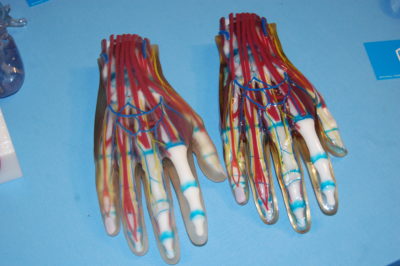
By Kathryn Young
The patient – a wounded soldier – had a severe facial deformity, and Dr. Frank Rybicki found it psychologically difficult to prepare himself to meet him.
“My medical training helped me respond to his sensory defects: sight, sound, smell and taste,” explains Dr. Rybicki, who helped found the 3D printing lab and program at The University of Ottawa and The Ottawa Hospital. “However, when people meet each other, we connect with their faces and recognize each other later by their face. I felt both medically responsible and challenged to help artfully repair this soldier’s damaged face.”
In an article published in The Lancet in February, Dr. Rybicki discussed how, in the mid-20th century, plastic surgery options were limited. But today, 3D-printed patient-matched implants can help restore function. For this soldier, Dr. Rybicki was able to help restore his functions (of chewing, swallowing, breathing and speaking) as well as his form – his appearance.

“We can now digitally change anatomy and then design and create new anatomical parts for injured patients, helping transform their lives,” says Dr. Rybicki, who has taught innovative medical technologies to a generation of physicians, and is considered a father of medical 3D printing. “3D printing helps change how these patients perceive themselves, and how others perceive them.”
At the same time, he explained in The Lancet, 3D printing is also transforming how doctors perceive themselves. As more hospitals set up 3D printing labs, as at The Ottawa Hospital, the field has begun to weave technology and art together.
“When I trained in the 1990s as a physician-scientist and academic radiologist, I studied theories and methods with a technical, as opposed to an artistic, focus. I looked for ways to scan patients faster and more precisely – methods that are still important,” he says. “But 20 years later, I’ve discovered that the creativity that comes with 3D printing has led to it becoming an art form in medicine, with ‘physician-artists’ working in a new studio – the hospital.”
Medical 3D printing is a form of art because experts can use radiology equipment to digitally change the patient’s anatomy, and then create a new physical version of the patient. As physician-artists do this work, they bring new skill sets into hospitals, such as computer-aided design. They have inherent artistic license as they design, produce, clean and present 3D medical models.
“As a physician-artist, I know when a design is ‘just right’,” he says. “I will think, or openly exclaim, ‘Don’t touch it anymore. lt’s done. lt’s beautiful.’”
For years, companies have produced medical models using their wider resources and greater expertise in design and manufacturing. They are, however, bound by industry manufacturing standards.

By contrast, when a 3D-printed part is created for personalized medical care, physicians have artistic as well as medical license and a responsibility to treat patients safely. As this field grows, Dr. Rybicki says, there are concerns that physician-artists have too few boundaries imposed on them.
“Think of how, in representing the human body, an artist can distort proportions for emphasis or to evoke a feeling,” he pointed out in The Lancet article. “To what extent does such artistic freedom shape the work of physician-artists specializing in 3D printing? How do they resolve the tension between artistic endeavor and clinical need?”
Through his own work, Dr. Rybicki has identified three key constraints that generate a healthy balance between 3D printing as an art form versus 3D printing as an emerging, materializing medical technology.
- Challenges in designing a model intended to replicate a patient’s anatomy. For example, in oncology, physical models of patients with lung tumours close to the clavicle and the upper rib cage must be accurately designed to include critical, adjacent vessels, nerves and bones. The 3D model often provides information that is otherwise unavailable, to help the physician determine whether or not the tumour is operable. In another example, 3D models are required for surgery in babies with complex congenital heart defects, and the physician-artist must decide which cardiac details to include in the model design. Surgeons must have models that are as anatomically accurate as possible, so their artistic license is constrained.
- When the physician-artist must alter the patient’s anatomy. ln planning a facial reconstruction after a disfiguring injury, for example, the physician-artist has competing challenges and priorities: the patient’s need to chew, salivate and breathe; how repairable the tissues are; and the desire to restore the face based on ‘before’ photographs. To meet these challenges, the physician-artist must integrate medical data to improve form and function for the patient’s existing anatomy but within specified limits.
- Choosing the patients who can benefit the most from 3D printing, given the costs of operating a lab within a hospital. “Just because a physician-artist can make a model doesn’t mean that doing so is a best use of resources,” says Rybicki. For patients with specific conditions – such as in areas of oncology and orthopaedics – the evidence is showing that 3D printing could save time and money and improve clinical outcomes. However, evidencebased guidelines for appropriate use need to be developed.
Dr. Rybicki is now charting a course for 3D printing to be reimbursed, so that the technology can be brought to patient care in a more structured, unified way. The challenge is medical, and artistic.
“One layer at a time, one patient at a time, and one hospital at a time, 3D printing is inching medicine closer to personalization,” says Dr. Rybicki. “The act of creating 3D models and implants palpably brings art to medicine. The tension between artistic license and clinical constraints will continue to establish an equilibrium state in which 3D printing in hospitals enhances the quality of care we deliver and improves patients’ quality of life.”
Kathryn Young is the Publications Officer at The Ottawa Hospital.

